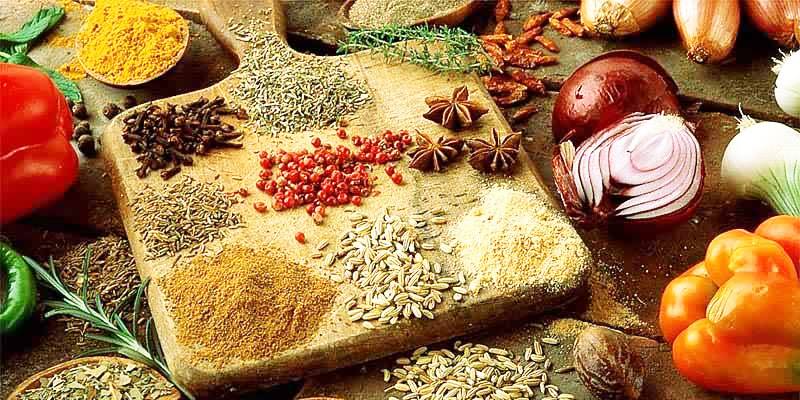 In the treasure chest of Persian ingredients, the spices are the twinkling jewels. The cardamom being its emerald and saffron its rubby, spices in Persian food culture are inseparable elements to this enchanting cookery.
In the treasure chest of Persian ingredients, the spices are the twinkling jewels. The cardamom being its emerald and saffron its rubby, spices in Persian food culture are inseparable elements to this enchanting cookery.
From the humble cinnamon to the luxurious saffron, the zingy dried lime powder to the warmth of ginger, the aromatic spices permeate the air and caress the taste buds. In Persian cooking, spices are used to give warmth, flavour and aroma to dishes, rather than heat. This certainly makes Persian recipes ideal to those sensitive to chili.
Spices aside, herbs are also part of a Persian kitchen cupboard staples. Dried or fresh green herbs such as parsley, coriander, mint, tarragon, dill and fenugreek are vastly used in the majority of Persian main dishes and starters.
Fruit and nuts are also integral to Persian cooking. Indeginous barberries, dried apricots, raisins, quince, plums (prunes) and apples all have a leading role in dozens of Persian recipes. As Iran is a land of growing walnuts, almonds and pistachios, these ingredients have a special place in the heart of Persian sweets and savoury recipes.
Herbs, spices, nuts and dried fruits are the backbone of Persian cuisine and give magical and distinct flavour to this rich cooking.
saffron (zaaferan)

Iran is responsible for over 90% of the global production of saffron. Just like rice cultivation, the picking of beautiful saffron is done by the Iranian woman. Covering their faces to protect themselves from the aggressive sunshine in Khorasan province, they all line up almost crawling on the ground to pick the flowers of the most expensive spice in the world.
The delicate flowers pop only ten days a year. The process of separating the sunkissed stigmas takes so much effort which is also one of the reasons why saffron is very expensive.
This delicate sweet spice eventually finds its way on top of the rice as well as sweet and colourful baklavas and aromatic saffron rice pudding. The journey of this ruby-like spice does not stop there. It travels to Spain to rest in paella, the bouillabaisse of France, Swedish saffron buns or Indian curries - making saffron a crucial part of global cuisine. From golden saffron rice topping and saffron rice pudding to the last addition of taste to lamb and aubergine stew, this gem-like spice is tied to Persian cuisines and is used in lots and lots of sweet and savoury dishes.
The best way to get the most flavour and colour out of the saffron is to steep it.
- grind 2 teaspoons of saffron pistils to a fine powder using a pestle and mortar
- add 30ml (2 tbsp) of boiling hot water
- set aside to soak for 5 to 10 minutes
- add four spoons of rice to the saffron juice
- mix until all the rice is coloured
To have the most intense colour you can steam saffron inside the rice pan. To do this, prepare the saffron according to the instructions in a little cup and then place the little cup inside the rice pan after the water of the rice is evaporated. Put the lid on and let the saffron brew and give away all the colour with the rice steam.
Some mothers use ice cubes to get the best colour out of saffron and that is by adding ice cubes to grind saffron and letting it sit for a few hours. My grandmother used to put some sugar cubes in a mortal and pestle and ground them with saffron. She explained that sugar cubes helped saffron ground much easier.
The harvest of saffron has been in jeopardy for the past two decades due to a devastating drought. In order to survive some farmers have to resort to more sophisticated irrigation systems but the government is reluctant to provide assistance.
Poor marketing means Iran has not always got the credit it deserves as the home of red gold. Saffron is worth a lot in Iran, but over four times more expensive abroad due to the imposed economical sanctions by the US. Countries like China take advantage by buying the Iranian saffron at a very low price and sell it at the high market price globally.
order saffron on Amazon.nlHere are some of my recipes in which this delicate and exotic spice is used:
Persian hogweed (golpar)
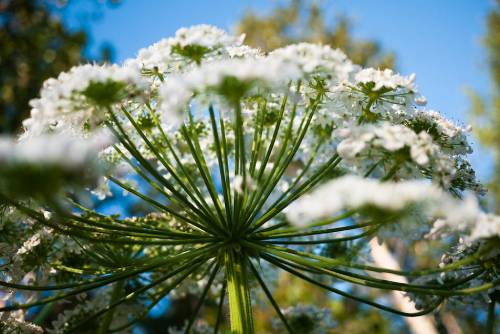
Golpar is an indigenous Iranian spice growing wild in humid mountainous regions and cannot be cultivated or planted in the European Union (Invasive Alien Species of Union concern).
It has a touch of bitterness and is slightly citrous-like with a very pungent aroma that cannot be mistaken for any other spice.
Golpar is mainly a sprinkled kind of spice rather than having it used inside dishes while cooking.
The seeds are often sold in herb shops and can be ground upon request. Some brew the seeds like tea believing it could warm up your body. The petals are used in a spice mixture to season rice, chicken, fish and bean dishes.
Iranians use golpar on cooked beans or lentil soup to counteract the effect of flatulence or food that might cause diarrhea. On cold winter days cooked broadbeans are sold on carts on the streets where golpar is the spice the seller often finishes the packing with, indeed to bring some aroma and warmth.
turmeric (zardchoobeh)

Turmeric is an inseparable part of our cuisine. Curcumin is the key active ingredient in turmeric, hence the spice is also known as curcuma. This not spicy spice gives colour and aroma to the majority of Iranian stews and takes the dishes to the next level.
Turmeric does not specifically have a pungent taste nor does it really stand out in dishes, but the addition of this humble spice not only takes away the unpleasant smell of raw meat and poultry but it also adds a rich flavour without being hot.
This magical spice is also used in traditional and homemade bread and can even be a finishing touch to our french fries next to our Persian cutlets, ghormeh sabzi or abgoosht. Most spice mixes such as curry and masala contain turmeric as well. Iranains love their turmeric in their food like they admire their colourful handmade carpets on their floor. For me personally, the turmeric jar is the biggest spice jar I keep in the cupboard. We buy turmeric by the kilo instead of small packages.
The love for this golden spice doesn't stop there. Iranians brew turmeric roots like tea and drink it on a cold winter day and it is truly like a warm thick blanket all over your body.
Being more creative with turmeric, I love my new creation which I call turmeric latte. I simply mix one teaspoon of turmeric in 250ml of milk and sweeten it with some honey or any natural sweetener. Then I make some milk foam in a milk frother and add it on top. As finishing touch I sprinkle some golden turmeric on top and serve it next to a buttery and crunchy biscuit.
A little hint: If you have just french topped your nails and would like to keep it that way, be careful when getting your hands on turmeric. The smallest dust can stain your nails for quite some time.
order turmeric on Amazon.nl
dried lime (limoo amani)

Dried lime is vastly used to add sourness to Iranian stews. Iranians buy their dried lime at grocery stores or herbal shops as it’s quite a painstaking procedure to make it at home. Dried lime is not just lime that is sun dried - it is first boiled in water and vinegar and then dried under sunshine in special conditions.
This specific lime is from the beautiful city of Shiraz. They are smaller in size and more sour with a very pungent aroma. Shirazi dried lime carries a lot of flavor and adds a special layer to food. The addition of dried lime in food often takes place at the end. Dried lime that has been soaking in warm water is added to stews 15 to 30 minutes before turning down the stove. Some make holes in the lime using a fork in order to get maximum flavor.
It is also a personal choice to break down the dried limes and remove the skin and seeds, avoiding possible bitterness, before adding them to stews. Some also grind after removing seeds and skin and sprinkle it on top of their rice dishes and stews giving their dishes a mysterious taste.
Like most herbs and spices in Iran, dried lime can also be used in tea or brewed on its own and sweetened with sugar candy. Nowadays dried lime can be found readymade in any form such as powdered, flakes and even sliced for flavoring tea.
Here are my recipes to which dried lime can be added:
cumin (zireh)
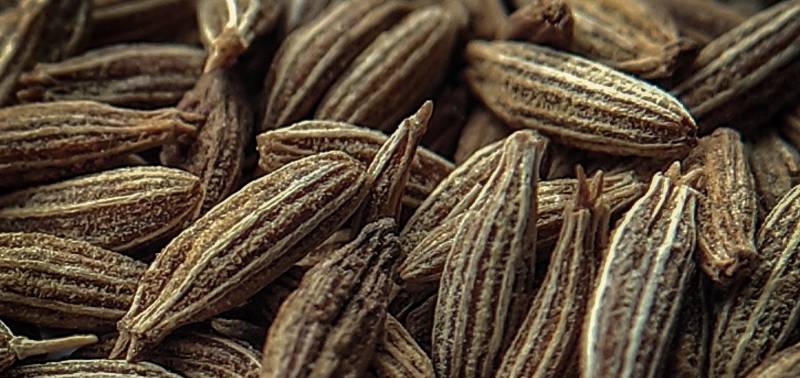
Cumin is widely used in mixed rice and stew spices if not frequently on its own. In Kerman they cook their rice with cumin seeds and serve it with chicken or lamb stew, but cumin is mainly used in a ground form mixed with other spices such as cinnamon, turmeric, ground ginger and garlic and onion powder.
The mix of spices in Iran is widely used in stews and rice dishes and cumin adds a distinct flavour. To add some warmth and surprisingly pleasant flavour, my mom always added a handful of green or black cumin seeds to a pack of storebought cream cheese and spread it on flatbread with some mint and basil leaves and served it as our afternoon sandwich in front of the tv.
For us Iranians, Kerman is the city where cumin comes from. Cumin has found its traces in our rich literature as well. We say "do not take cumin to Kerman" referring to taking unnecessary actions.
Here are some recipes to which cumin can be added:
cardamom (hel)
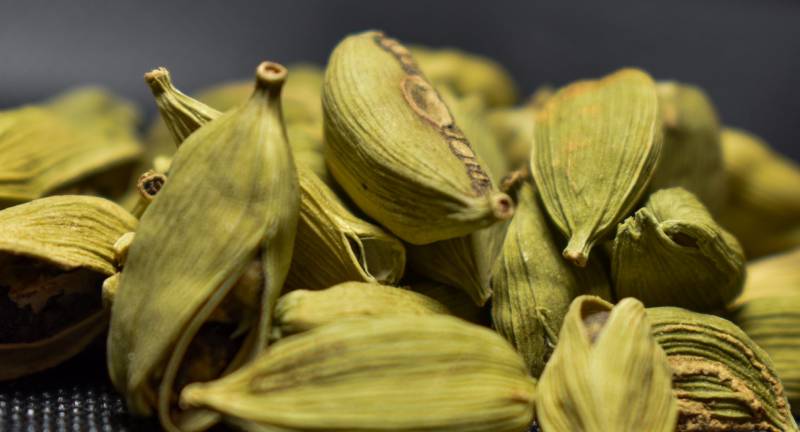
Cardamom is the world’s third-most expensive spice with vanilla and saffron taking the first and second places. If saffron is the rubby of the Persian spice cupboard, cardamom is definitely dubbed the emerald.
This beautiful green skin holds aromatic black seeds in its tiny belly. Persians use cardamom in an extensive variety of dishes, cookies and even their tea.
Ground cardamom is an inseparable spice in Persian cookies and baklavas. To grind cardamom it is best to use it as a whole. Though it is believed that the main aroma lies in the seeds, the husk should not be underestimated. Grinding with husks makes the grinding procedure easier and pervades much more intense aroma.
order cardamom on Amazon.nlHere are some recipes with cardamom:
sumac (somaq)

Sumac for us Iranians is an uninvited guest next to our kebabs when we go to restaurants. Sumac is a dark red powder that has a zingy and sour taste. It is a sprinkle on top of our greasy lamb kebabs instead of dripples of lemon juice believing that it can help alleviate the fattiness of the kebab just a little bit.
I personally do not like to ruin the taste of my greasy kebab either with sumac or with lime but just to indulge and enjoy the taste of my kebab.
I have heard that in Ardebil sumac rice is in fact a traditional Iranian dish. In this dish, a great deal of sumac is simply added to the rice and then served with meatballs or big chunks of lamb shanks.
Some people add sumac to their meatball mix along with salt and pepper and turmeric to add some zing and extra flavour. This addition could be the one ingredient you'd be wondering about what it is - whilst having the meatball melting in your mouth as it's exotic and surprising in dishes.
order sumac on Amazon.nlSumac can be added to any kebab or meat dish.
cinnamon (darchin)

The familiar smell of cinnamon makes every kitchen feel homier. For Iranians using cinnamon in savoury dishes is a daily practice and it takes this pantry stable beyond cinnamon rolls and carrot cake spice.
Cinnamon in savoury dishes is an inseparable spice. When it comes to our cinnamon we do not suffice a gentle sprinkle but we often add a heaping spoon of this aromatic and irresistible spice.
Cinnamon in Persian desserts holds a special place. A generous sprinkle of cinnamon in saffron rice pudding is what makes this dessert a memorable one.
While commonly used in sweets and festive baking, cinnamon in Persian cuisine is a powerful and widely used spice in savoury dishes as well. When adding it to savoury dishes, mind that it is best for cinnamon to be added at the last step.
Cinnamon stick is also used often in our Persian black tea while being brewed on top of the steaming kettle along with cardamom. So if you have special guests and you want to have them taste the real Persian tea fusion, in a teapot put one teaspoon of black tea leaves, one cinnamon stick, two broken cardamom pods, a pinch of saffron and two rose buds and cover it with boiling water. Put the teapot on top of a boiling kettle and let the steam of the kettle do the rest of the work. This process emerges all the aroma and taste of the herbs and the tea leaves. Fill half of a cup with this tea mix and the other half with hot water from the kettle. Enjoy it with a saffron pistachio cookie or glutten-free bereshtook cookie.
order cinnamon on Amazon.nlSome recipes with cinnamon:
roses
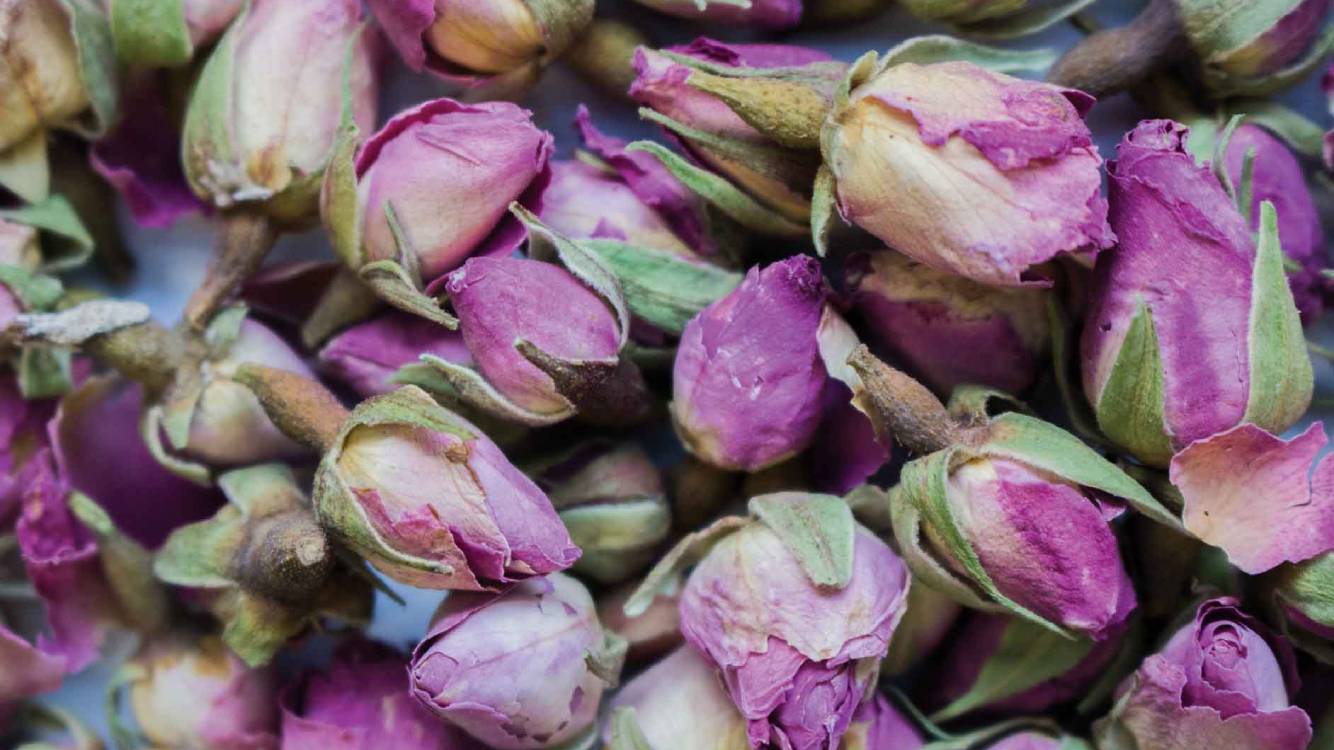
The rose field of Qamsar, a small town in Kashan in Isfahan province attracts thousands of tourists from all around Iran to witness the ritual of picking roses. This humble town is one of Iran's main producers of rosewater. The callused but nimble hands of the locals break the fragile blossomed buds before putting them in their long pouches hanging off their waist and neck. This special and unique ceremony happens mainly in April and May when the field is carpeted with pink colour of the roses and the air is filled with the aroma of these Persian roses.
These roses are eventually distilled into rosewater and distributed to the entire country or exported abroad. The petals are also sundried and sold as one of the most aromatic and quintessential spices of Persian cuisine. The buds are picked and dried with all the care and used to aromatise tea.
Dried rose petals are used frequently in Persian cuisine. From a sprinkle to our yoghurt dishes or in rice or stew advieh, these cute little pink petals have a special place in the Persian spice cupboard.
The little buds are also used in our Persian tea mix along with cardamom, cinnamon and even saffron. Bear in mind that one in the whole teapot goes a long way. Persian roses are the most versatile and generous flower known in any cuisine. From rose water and rose buds to rose petals whole or ground this pink beauty has a reputation around the world.
Some recipes with roses:
advieh
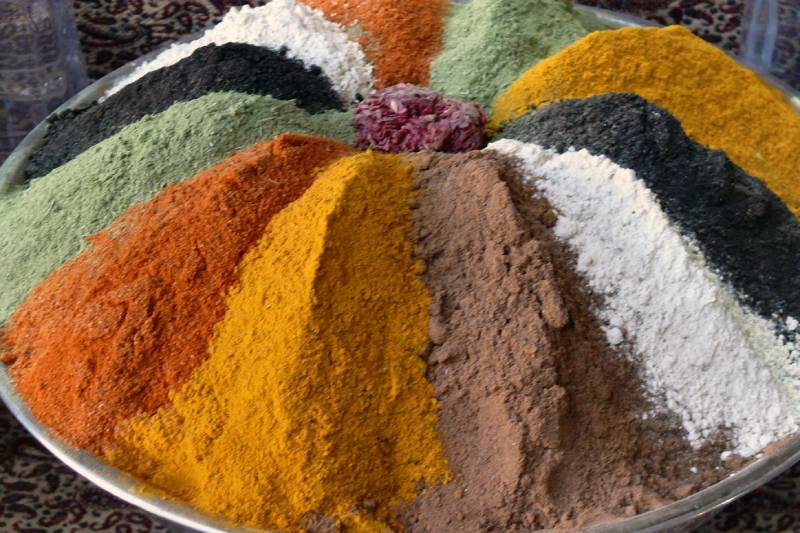
Advieh is a mixed-Iranian spice just like gram masala or curry in Indian cuisine. We have lots of different kinds of advieh in herbal shops: stew advieh, rice advieh, chicken and fish advieh.
Stew advieh is comprised of black pepper, cinnamon, turmeric, coriander seed and cumin. Depending on which herbal shop you buy your advieh from, the mix can be slightly different as sometimes herbalists can get more creative with the sack of their spices.
Stew advieh, as its name certifies, is used in stews. The mix is often added either when stir-frying the meat or at the last stage. Adding advieh at the last stage, the aroma is preserved better in the stew and you end up having a lighter stew as advieh can darken the stew a little bit.
Depending on what stew you are making, the advieh can vary as well. For example, you can't use the same advieh for ghorme sabzi as you use for gheimeh. The variation of advieh is enormous thus it is best to ask the herbalist what you are intending to cook.
In Persian cuisine, mixed rice dishes have a special place on our tables. Rice advieh is used to add a pleasant aroma to the rice mix and make it more memorable. One of those mixed rice dishes is rice with green beans and meatballs (loobiya polo). Rice advieh is often a mix of cinnamon, cumin, ground rose petal, ground ginger and nutmeg. Rather than relying on salt and pepper, Iranians love the addition of advieh to their dishes. It is a simple and easily accessible spice in one jar instead of going through your spice jars and adding one spoon of each of them.
The combination of earth cumin, floral rose petals and warm cinnamon infuses the rice and stew with extra aroma and tasty complexity that is present in every bite.
dill (shivid)

Dill in Iranian cuisine is more than just herb and a bit of sprinkle on top of yoghurt. Dill is the green of our rice mixed with fava beans served with lamb shank.
Like any other herb, when dried the aroma intensifies and a little bit of it goes a long way. Fresh or dried, dill is an inseparable ingredient in baghali ghatogh, this tasty and no-frills stew from the Caspian sea.
Dill doesn't always come on its own in Persian dishes but is mixed with other herbs such as coriander, leek and parsley. This mix is called sabzi polo translated to "rice herb". When cooking rice, the freshly chopped mix can be added to the rice right before the water is evaporated.
Dried dill is also used as a sprinkle on top of our yogurt as a side dish.
coriander (geshniz)

Coriander in Persian cuisine is not just a finishing touch to our soups. In fact, we use coriander as the major ingredient in our dishes. It is used in our most delicious and healthiest frittata as well as stews.
Coriander doesn't always come on its own in Persian dishes but is mixed with other herbs such as dill, leek and parsley. This mix is called sabzi polo translated to "rice herb". When cooking rice, the freshly chopped mix can be added to the rice right before the water is evaporated.
The rare but magical olive marination from the Caspian sea region also calls for a great deal of coriander to guarantee the taste in this exotic mix. For those coriander lovers, if you don't have the mix of all the herbs for sabzi polo or rice herb all-coriander-rice is another option. Serve this rice next to a bowl of chicken or lamb shank stew and enjoy the aroma of this delicate green herb.
Some recipes to which coriander can be added:
parsley (jafari)

In Persian cuisine, parsley is an essential herb in our soups. But it certainly doesn't stop there. Parsley is used in our most delicious and healthiest frittata like green kuku as well as stews like ghormeh sabzi.
Parsley doesn't always come on its own in Persian dishes but is mixed with other herbs such as dill, leek and coriander. This mix is called sabzi polo translated to "rice herb". When cooking rice, the freshly chopped mix can be added to the rice right before the water is evaporated.
fenugreek (shanbalileh)
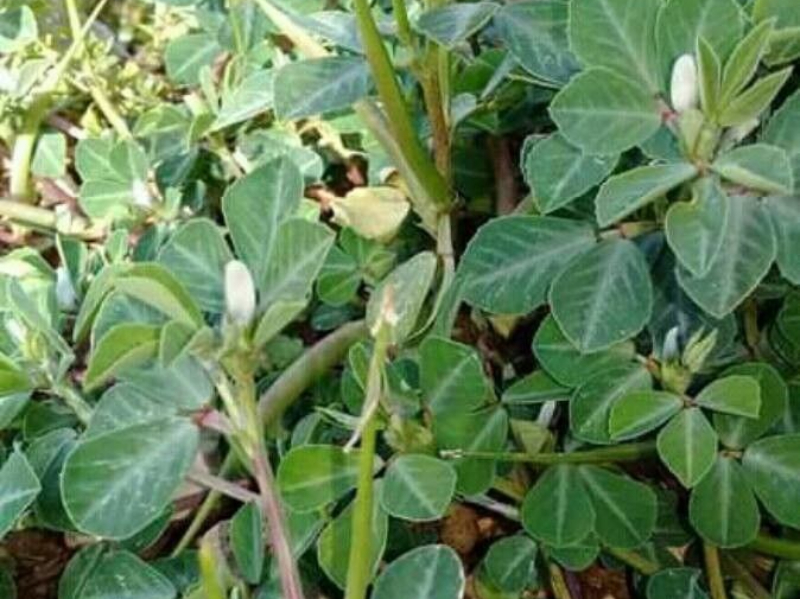
I don't know if fenugreek is the right translation to shanbalileh thus I'd like to call Iran the origin of shanbalileh - and nowhere else. Fenugreek might be similar to shanbalileh in shape but certainly not in taste and smell. I know two dishes that call for shanbalileh, the first one is the love of Iranians, ghorme sabzi and the second is eshkeneh.
In my ghormeh sabzi I have not included shanbalileh as ingredient because the concept of my food is accessible ingredients in Europe and I am afraid shanbalileh is not one of them. In Iran though, shanbalileh in ghormeh sabzi is the one essential ingredient which gives the memorable aroma to this flavoursome dish. In my opinion though the smell of shanbalileh is too pungent and when you eat ghormeh sabzi with this herb in it, even your pores smell like it for 2 days. It is as if you had asparagus and your pee smells for a day or two.
Eshkeneh is the most humble Persian food I know of. It is in fact named "the poor man food" as the ingredients are so humble and cheap.
- fry one onion in 2 spoons of oil
- add some turmeric
- add 2 spoons of flour
- add boiling water to it - gently to avoid the flour clumping up
- add 2 chopped potatoes
- let it simmer until the potatoes are cooked
- season with salt and pepper and sprinkle a handful of dried shanbalileh
Serve it in a bowl and shred some flat bread and enjoy your humble but truly tasty lunch.
leek (tareh)
Neither leek nor chives is the right translation for tareh. Tareh is a native Iranian herb that is used extensively in Persian dishes. Tareh only tastes like chive but in terms of looks it's thicker with a much more intense smell.
Tareh doesn't always come on its own in Persian dishes but is mixed with other herbs such as dill, parsley and coriander. This mix is called sabzi polo translated to "rice herb". When cooking rice, the freshly chopped mix can be added to the rice right before the water is evaporated.
Originally it is one of the main ingredients of green kuku (kuku sabzi) but in my recipe it is substituted with leek, as it is accessible in Europe. Leek is indeed a good substitution for tareh as it is not easy to find in Europe - if not impossible.
marzeh
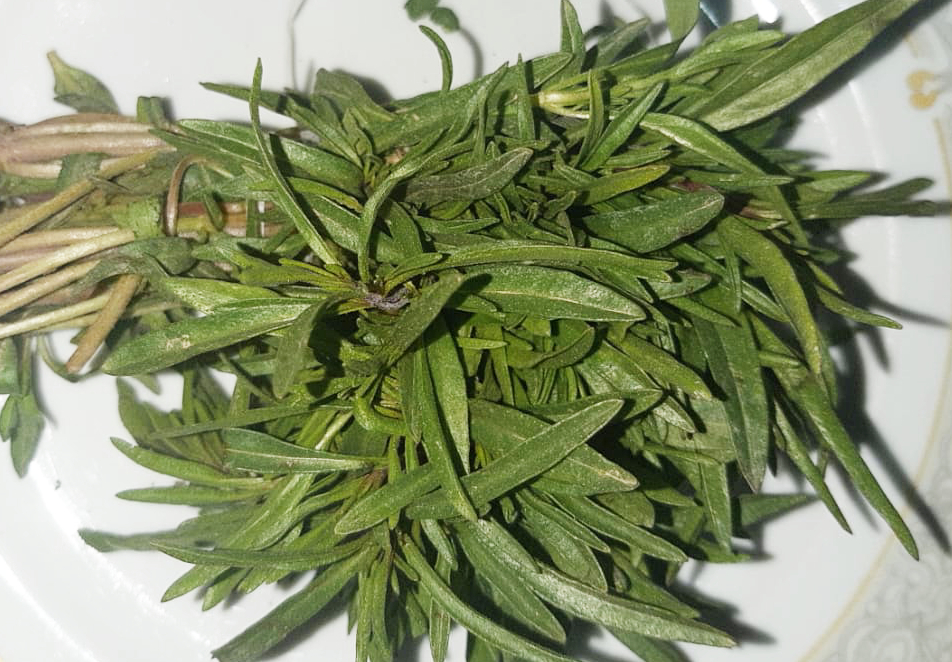
Marzeh - or as the English translator says "summer savoury" - is an aromatic Persian herb. I'd like to call it marzeh and not believe that the English translation is accurate. Marzeh is a local Iranian herb and only its original name suits.
Moving on from the name, the aroma of marzeh is unique and special. Marzeh is used fresh or dried in koofte or Persian meatballs. Just like other herbs, marzeh doesn't come on its own in dishes but is mainly dried and mixed with other herbs such as mint, tarragon and leek. This mix is called sabzi koofte or koofteh herb. You can find this mix in any herbal shop or even supermarkets.
Koofte is made in so many different ways in Iran. Rice koofteh is a mix of ground beef and lamb, rice, split peas, grated onions and of course sabzi koofteh or koofteh herbs. This mix is kneaded by hand to make sure all the ingredients are well combined. Then big meatballs are formed and set aside. The sauce simply starts with frying one big onion and adding tomato paste and spices to it and filling it with boiling water. Then the meatballs are gently placed in the pot and submerged in the sauce. To add more texture you can quarter one big potato and add it to the sauce. It is then served with naan lavash. You can shred bread in the sauce and enjoy it the traditional way.
The people of Tabriz make koofteh in a similar way but instead of raw rice and split peas, they cook them all beforehand. The size of Tabrizi koofteh is often much bigger than the first kind. Sometimes they put fried onions, barberries, dried golden plums, boiled egg, or even a whole cooked chicken with its belly stuffed with herbs and boiled eggs. Making tabrizi koofteh requires lots of experience and patience. I personally failed every time I tried. Simply because if you are not experienced and the measurement of your ingredients is not correct, your koofteh opens in the water and turns into a thick soup rather than koofteh. The most important is that they hold their shape after the cook. Mine didn't thus I am happy with the first version rather than the giant koofteh Tabrizi.
tarragon
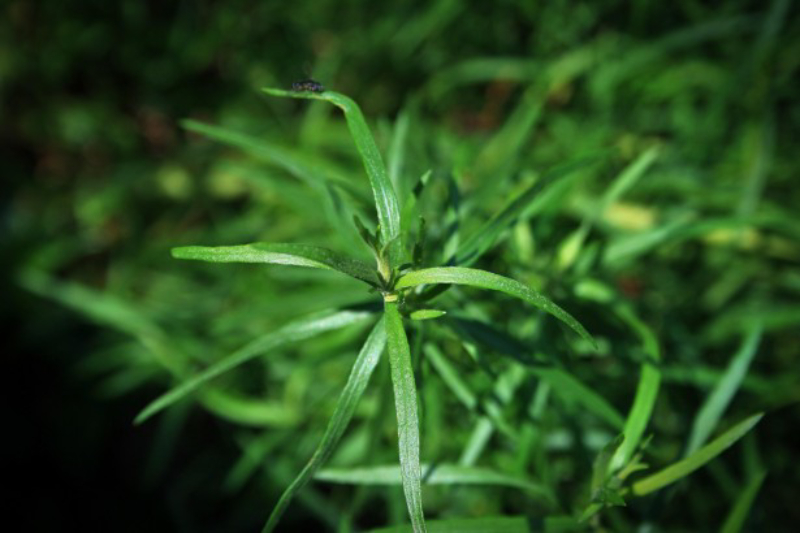
Tarragon is a subtle yet elegant herb. It adds a fresh spring-like aroma to dishes. Tarragon is used fresh or dried in koofte or Persian meatballs.
Just like other herbs, tarragon doesn't come on its own in dishes but is mainly dried and mixed with other herbs such as mint and leek.
This mix is called sabzi koofte or koofteh herb. You can find this mix in any herbal shop or even supermarkets.
tamarind
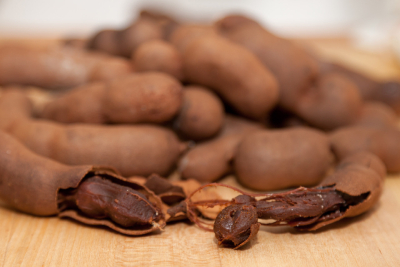
Though extremely versatile in south Asian cuisine, tamarind is not vastly used in Persian dishes. There is only one dish I know that the people of the south make with boneless fish and that is ghaliye mahi.
The green herbs used in this stew are the same as ghormeh sabzi. There's a great deal of coriander, parsley and fenugreek. The tamarind is dissolved in hot water and then passed through a sieve to remove the stones and roots and added to the dish to give the most desirable tanginess and sourness to this special stew.
mint

Aside from being used in tea and cooking, mint is used as a medicinal remedy in Persian households. Brew mint like tea, make a paste with it by adding plain flour and apply it on lance or infected skin diseases. Put a bandage on it and the next day the puss comes out and the skin is healed.
Dried mint is one of the staple Persian herbs that is used in lots of our legume soups. Noodle legume soup (Ash Reshte), is one of those dishes. The way dried mint is used in this dish is quite unique ad truly Iranian.
Put some oil in a little pan, add dried mint and some turmeric and put it on a gentle heat. The oil starts to get green and aromatic. It needs only a minute or so on the stove as more than that burns the mint. This green oil is then used on top of the Ash as garnish.
We also tend to sprinkle our dried mint on our yoghurt and cucumber dip. This dip is refreshing and is paired perfectly with rice dishes and kebabs.
dates

The south of Iran has the best climate to grow this sweet little fruit. Depending on where the dates come from, the shape and the taste are different.
The dates of Kerman are sticky and brown. The Hormozgan dates are long, thin and rather dry whereas the ones of Sistan Balouchestan are quite similar but slightly softer and lighter in colour. Sistan Balouchestan also has Zahedi dates which are rounder and very dry. The Boushehri and Khoozestani versions are dark brown, sticky and small and the ones of Fars are more like Sistan Balouchestan's.
Dates are a big part of Iranians' eating culture as they are used in various forms and served in different ways. Date syrup is what Iranians eat for breakfast. A piece of bread, a good slather of butter and some drizzle of date syrup is a perfect energy bomb to start the day.
Dates are also served in a tray at funerals expecting the person who takes a date says a blessing for the dead person. Saffron tea served with some dates on the side is the most Iranian tradition as well. Fried dates in butter can also find themselves on top of rice dishes such as lentil rice. It can be replaced by the sweet element of this dish, raisins.
Despite living in Europe, it is very easy for me to find Iranian dates even in non-Iranian supermarkets.
raisins (keshmesh)
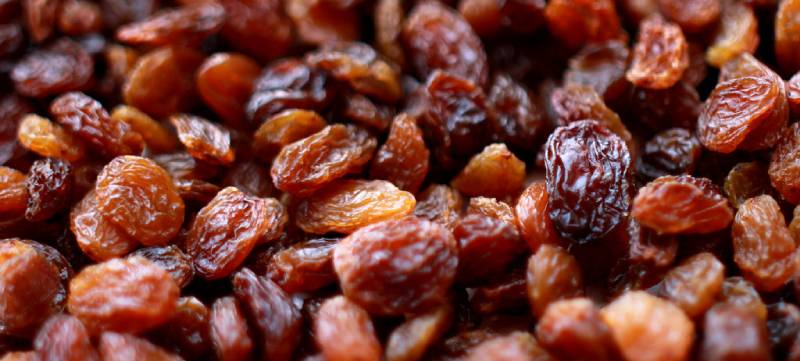
Raisins have found their way into lots of rice dishes hand in hand with walnuts, for example, balancing the crunch of nuts and the aromatic element of spices such as cinnamon. They are also incorporated into yoghurt side dishes where they soak in the acidity of yoghurt to create a distinct agrodolce flavour.
Raisins are vastly used in Persian dishes like lentil rice and yoghurt and cucumber dip. It is indeed universally known that their tangy-sweet flavor is great in desserts but the truth is that Iranians like them better in savory recipes. Trying one of the below-mentioned recipes might just sway you on this humble ex-grape - after all as they add depth and contrast to recipes.
golden plums (aloo bokhara)
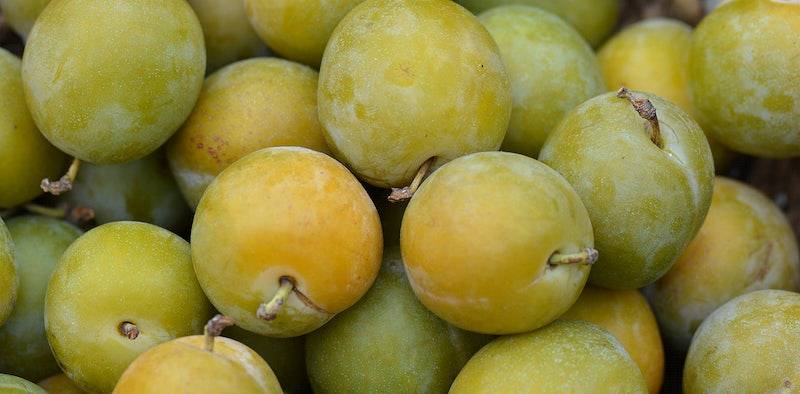
For Iranians, finding ways to use dried fruit is more than using them in oatmeal, cookies, or Christman bread. Golden plums are vastly used in Persian cuisine as their flavours give an added punch, like in pumpkin stew with golden plum.
Their concentrated taste and sweetness can lend a unique layer to savory dishes, such as chicken stew, lamb and apple stew, pumpkin stew and the most known, spinach stew. The chewiness of this golden dried fruit adds a nuanced sweetness to stews as such. Dried plums are rehydrated by being soaked in warm water for 10 minutes before adding them to stews. This way. their flavour disperses throughout the dish and they become plump and less chewy.
These stews are often made with chicken or lamb and they are served on a bed of white rice. Iranians love dried fruits. They use them not just next to the bowl of nuts on the table but make huge use of them in their sweet and savoury dishes.
barberries (zereshk)
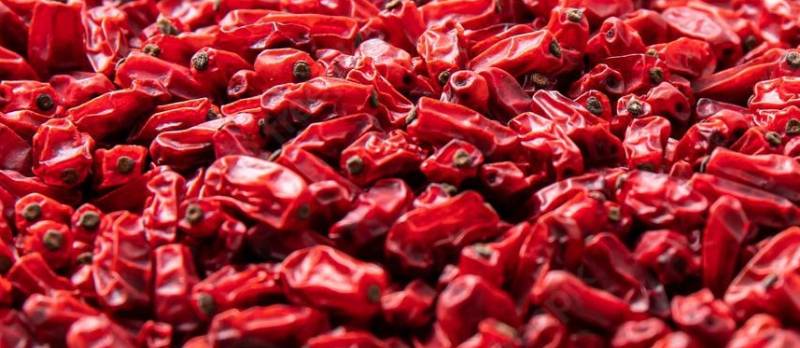
Barberries are the one and only indigenous Persian ingredient. They are the ruby of our rice next to chicken or lamb shank stew.
Barberries are by nature sour and tangy but when preparing them for the rice topping some sugar or honey is always added to balance the sourness. When sweetened it is irresistible on the bed of rice especially if fried in butter and mixed with the rich aromatic saffron rice.
To prepare barberries, you should keep in mind not to overheat them. You do not want the gorgeous redness to turn dull and brown. Stir fry it on low heat in butter for 2 minutes. Then turn the heat down and add some honey or sugar. Make some saffron rice and add it to the barberries mix and cover the top of the rice with it.
dried apricots
Dried fruits are often key additions to sweet and savory Persian dishes. Dried apricots not only lend themselves beautifully to chicken stew, but they are a pleasant delight on our tables on cold autumn days. These golden soft and juicy goodies are also found in our nut bowls. Similar to Morrocan tagin, dried apricots are used vastly in our lamb or chicken stews. They can be replaced by or even paired with dried golden plums in dishes such as pumpkin stew with dried golden plums.
Eating dried fruits on their own in Iran is a daily habit. We love snacking on dried apricots, raisins, dates and lavashak which is a dried form of fruit puree.
pomegranate
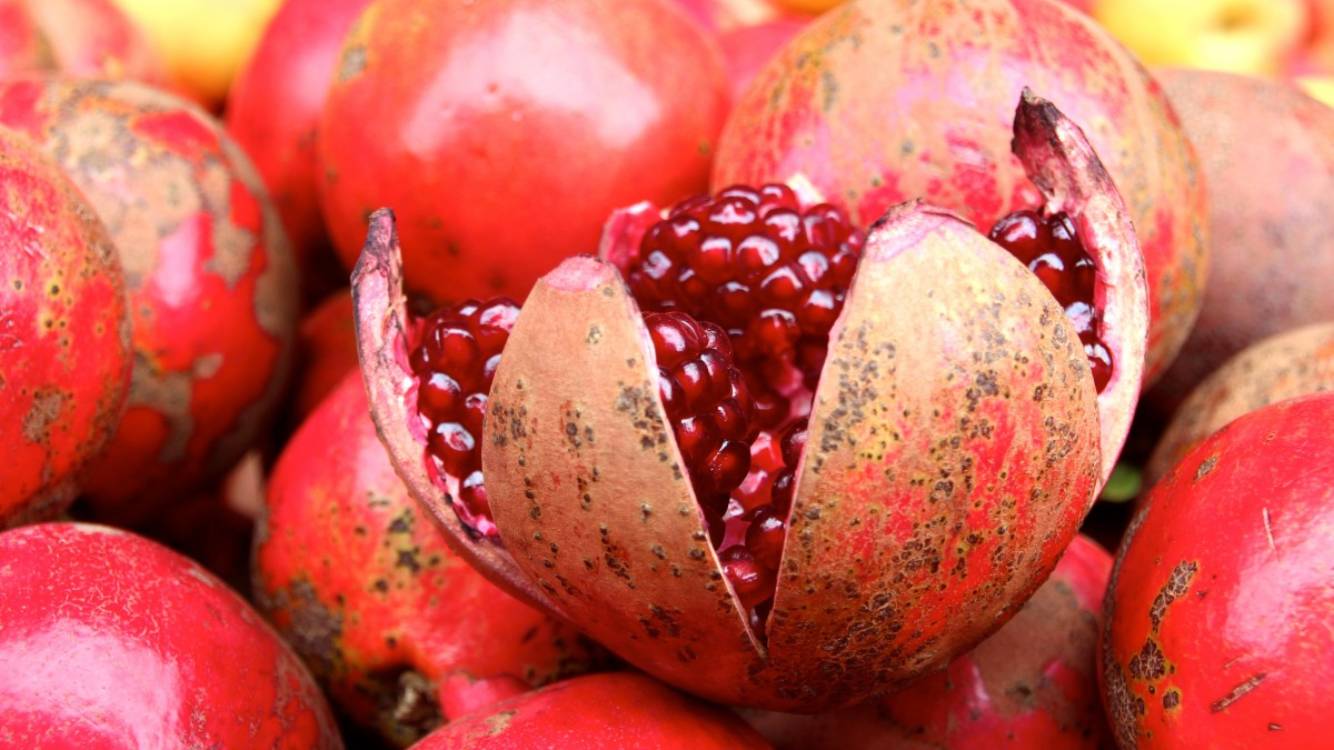
Pomegranate and Iran are somehow intertwined. We grow this heavenly fruit in Shiraz, Saveh and Isfahan. We use pomegranate to the fullest. From pomegranate seeds and pomegranate molasses in Persian stews to pomegranate juice and pomegranate lavashak, this gorgeous-looking fruit has a special place in Iranians' hearts.
Pomegranate molasses is simply evaporated and condensed pomegranate juice which is mainly used in our beloved stew called fesenjoon. Fesenjoon is one of those exotic stews that is made with lots of ground walnuts, meatballs or chicken pieces and an abundance of pomegranate molasses. In some areas like the north of Iran, they add pumpkin puree or prunes to their pomegranate molasses to add more thickness to the sauce.
In Yalda night, which is believed to be the longest night of the year and the celebration of the beginning of winter, there is always a big bowl of pomegranate seeds sitting on the table elegantly. We often sprinkle some Persian hogweed (golpar) on our pomegranate bowl for some extra aroma and zing.
Pomegranate juice for us is as common as orange juice everywhere else. We even have specific shops that sell all pomegranate products such as molasses, seeds, lavashak or even pomegranate ice cream and jelly. The most famous pomegranate shop in Tehran is Mohammad juice bar.
The north is known for its scrumptious olives and Persian marinated olives (zeytoon parvardeh) is one of those side dishes that Persians are totally crazy about. When they travel to the north they often bring a bucket of these yummies as a souvenir. In these loved side dishes there is always an abundant amount of pomegranate molasses.
Pomegranate is literally named fruit from heaven in Persian culture. They say eating it during pregnancy gives you a beautiful baby. This must be a myth and not based on scientific facts but it is cute to learn how far the love of Iranians for this fruit travels.
orange rinds
You might have seen thick orange rinds dunked in chocolate halfway only in Christmas markets or chocolate shops - but for us Iranians orange rind goes beyond that. Sweetened orange rinds come in boxes or packages in supermarkets or herbal stores and they are mainly used on top of our rice along with barberries, saffron and slivered pistachios. The addition of this sweet ingredient in our rice dishes is to balance the sourness of barberries and give an extra layer of flavour and chewy texture.
The combination of orange rinds and pistachios in cakes is absolutely amazing. orange blossom pistachio cake and orange and pistachio cake are the two cakes that you fall in love with after trying it once. They are both crowd pleaser desserts and a tasty finish to any dinner. Sweetened orange rind in Persian cuisine is a unique ingredient which adds unforgettable aroma to rice dishes.
quince
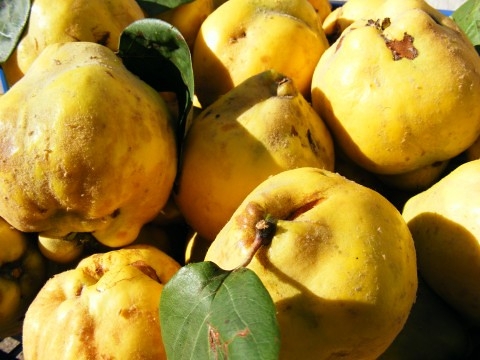
Featuring quince, this autumn quintessential fruit in savoury dishes is unique in Persian cuisine. As quince and beef, lamb and chicken work together perfectly, there are quite a few stews that prove these combinations are a match made in heaven. The instructions and ingredients to make this stew are exactly like the ones for pumpkin stew with golden plums. The only difference is that you replace quince with pumpkin. In comparison to pumpkin, quince is tougher and needs more time to cook. For this recipe, quince should be peeled.
Quince jam is also one of those truly Persian jams like carrot jam. To make quince jam, you have to have some strong arms to cut the quince into small pieces. Quince may look like apples but it is very hard inside and takes so much effort to peel and cut it. Though quince is yellow, it is stunning to know that quince jam is red and not yellow. This happens when quince is cooked in sugar and water for at least one hour with the lid of the pan on.
This jam is chewy and tastes heavenly on warm bread and a thick slathering of butter. This is one of the combinations you could find on an Iranian's breakfast table.
grape juice (ab ghooreh)

Grapes are one of our most fascinating and versatile fruits. Before grapes become grapes, they are green and sour. For us Iranians, they are the best seasoning in the stews that add the most stunning sourness to the dish. We call them ghooreh. We pick ghooreh and use it in all sorts of ways. We wash them and remove the stalks and place them in little ziplock bags and then freeze them. When cooking stew ghooreh can be added at last for the delicious and secretive sourness. It can also be replaced by dried lime (limoo amani).
Another way to use it is to juice it. The best way to juice is to first remove the stalks as they give a bitter unpleasant taste to the end result. Abghooreh or sour grape juice is vastly used in our salads such as Shirazi salad and so many of our stews.
There are in fact seasonal shops that are specialized only in juicing sour grapes and lime. Iranians tend to keep bottles of sour juice in their cellars for the use of the whole year. The residual of the sour grapes after juicing does not go to waste at all! We dry them in the sun and then grind them to powder and keep them in jars. We then sprinkle the sour grape powder on top of our stews to give a magical taste to them.
pistachios (peste)

Iranian pistachios come from Damghan, Semnan province and Rafsanjan, Kerman province. With their emerald colour and distinctive flavour, pistachios are as tasty in savoury dishes as they are in sweets. Pistachios often sit on bed of white rice combined with barberries and saffron to impress the guests by their greenish beauty.
In Iran, pistachios are used in so many different shapes. Slivered pistachios are often used to garnish sweet and savoury dishes as nothing can liven up a Persian dish like a little bit of crunch.
Whether you are preparing dinner or dessert, there is always a way to enhance the flavour and texture of the dish by incorporating this charming and cute green nut.
When buying pistachios in shell in nut shops in Iran, you'll see at least 8 different sacks of pistachios varying by size, taste and the way they have been roasted. To be able to choose your favourite, you get to taste all of them. The shopkeeprs always offer them to taste with pleasure.
Here are some recipes with pistachios:
walnuts

Walnuts require a mild and frost-free climate in spring and extremely hot summers. The western provinces of Iran are perfect for this round cute nut to grow.
Walnuts have a special place in Persian cuisine. Fesenjan is the most known stew which requires lots and lots of well-ground walnuts. This stew is prepared with pomegranate molasses and meatballs or chicken pieces.
Persians are very picky when it comes to choosing their walnuts. The best walnut has to have a light colour and if in the peel, it has to have a soft shell to make it easy to break and reach the kernel.
It is also important to keep the nuts away from moisture in a sealed jar. Freshly baked lavash feta cheese from Tabriz and broken walnuts spread on the bread are the most popular and delicious combination for breakfast, or in my case, the most frequesnt school sandwich I had with me to enjoy during my breaks.
At funerals it is also common to put one-quarter of a walnut inside a core-free date and serve it to the guests. Fresh walnut is also something I am personally crazy about. One of my childhood's freshest memories is hearing walnut vendors going street to street yelling "fresh walnuts" when walnuts are in season. You often find them with stained hands getting walnuts out of a big jar filled with salted water. Those walnuts are the best! They are tasty and juicy and go perfectly well with an extra sprinkle of salt.
Interestingly, it's not just the kernel of this fruit that is used. The green walnut peel is also worth money as it is used to colour the woolen thread for carpets. This tradition is mainly used in Isfahan and Kashan.
Here are some recipes with walnuts:
almonds (badam)

Almonds, the inseparable nut of the Haftseen. Iran is the third biggest almond producer in the world. With that in mind, almond comes in various shapes and qualities.
Roasted and salted almonds are the favourite of most Iranians in their nut bowls. Slivered almonds are what is mainly found on top of our jewelled rice along with barberries and saffron rice.
Ground almond or almond flour is also vastly used in rice pudding as baby food and if it is served for adults it always goes with a sprinkle of cinnamon.
One of the most popular cookies called pistachio jewelled biscuits (ghorabiyeh) are made out of almond meal and are of course kissed by beautiful pistachio kernels at the end.
Some recipes with almonds:
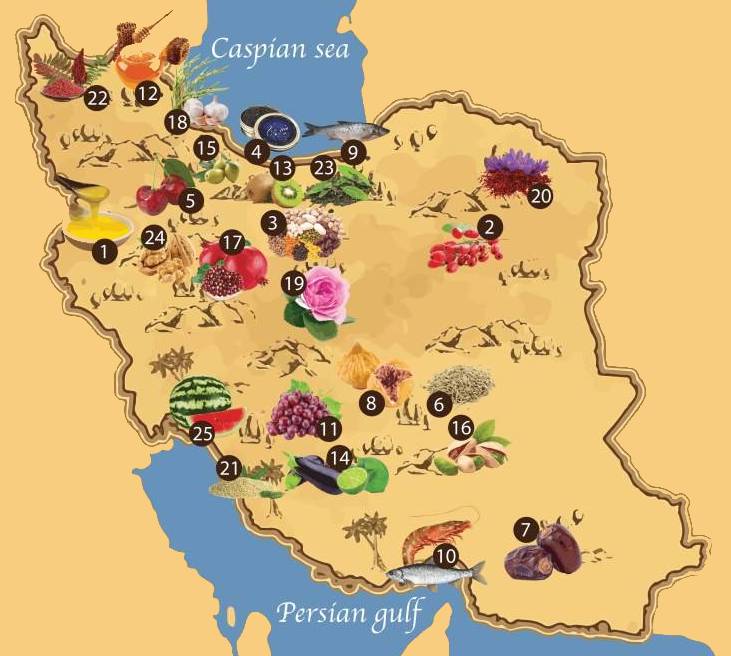
- 1: animal oil (Kermanshah)
- 2: barberries (Birjand)
- 3: beans (Tehran)
- 4: caviar (Caspian Sea)
- 5: cherries (Alamut)
- 6: cumin (Kerman)
- 7: dates (Bam)
- 8: figs (Estahban)
- 9: fish (Caspian Sea)
- 10: fish and schrimp (Bandar Abbas)
- 11: grapes (Shiraz)
- 12: honey (Sabalan)
- 13: kiwi (Ramsar)
- 14: lemon and eggplant (Jahrom)
- 15: olives (Rudbar)
- 16: pistachio (Rafsanjan)
- 17: pomegranate (Saveh)
- 18: rice and garlic (Rasht)
- 19: rosewater (Kashan)
- 20: saffron (Mashad)
- 21: sesame (Bushehr)
- 22: sumac (Hurand)
- 23: tea (Lahijan)
- 24: walnut (Tuyserkan)
- 25: watermelon (Ahvaz)